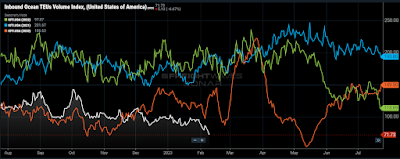
Right now it appears that the pipeline is choked with goods while the end market is backing up tying up space. It is a long time since we had inventory problems like this. Recall that pre 1990, inventory problems were endemic in all industry. Computerization ended all that with just in time delivery.
Now we have inventory sitting in containers traveling three months. This is not a welcome issue as inventory driven recessions were part of our past. It is now going to take years to really sort this out and storing inventory may either become a plan again or better yet, we need giant airships built able to make the trip in a month instead of three for much the same cost profile and all that.
That way problems can be readily offset.


Import demand continues to fall - Maritime data suggests shippers still struggling with demand
Saturday, February 11, 2023 Photo: Jim Allen - FreightWaves
0:00 / 4:24
Average daily bookings for container imports were half of what they were in January of 2022 and 25% lower than pre-pandemic 2020. And while the Lunar New Year has depressed bookings over the past few weeks, there was little pre-holiday shipping buildup before the dead period. Should we feel optimistic that demand is normalizing?
The Inbound Ocean TEUs Volume Index (IOTI) measures twenty-foot equivalent unit (TEU) container volumes being booked for shipping by actual departure date from their ports of origin bound for the U.S. — effectively the furthest upstream view of finished goods in supply chains available in aggregate.
In May, this index predicted a huge drop-off in goods entering the country by declining 30% in a matter of weeks. The implication is that shippers realized they had too much stuff and nowhere to put it as consumer demand had eroded faster than expected.
Inventory correction has been the theme of this year’s shipper-initiative playbook because of this. Retailers specifically have struggled with a glut of goods ordered during a period where supply chain congestion made it nearly impossible to receive their orders in a predictable manner, thanks to unexpected demand spikes resulting from the pandemic lifestyle.
Once those bottlenecks started clearing last year and consumers left quarantines and lockdowns, companies were left with a pile of items they could not sell.
Although talking about ordering practices and goals is valuable, the reality is most plans are rarely executed perfectly. In order for shippers to rightsize inventory, they still have to accurately forecast demand, something few if any have done effectively over the past three years.
The IOTI is showing that shippers are still shrinking their total orders. And while they did increase bookings slightly from China before the Lunar New Year dead period — when many Asian countries cease production for multiple weeks — the aggregate figure was not pushed much higher as it normally is in December. This indicates they do not foresee any strong demand increase over the next six to eight weeks — the average length of time before goods are needed after ordering them.
The latest Logistics Managers’ Index (LMI) report validates the idea that companies still haven’t quite figured out inventory management. Our article from a few weeks ago discussed the inventory-level component of the LMI and how it showed expansion in the growth rate of inventories in December. That trend continued in January as the inventory levels subindex grew from 56 to 62. Values above 50 indicate expansion, while those below it show the rate of contraction.
An acceleration in inventory growth at this point is somewhat unexpected considering shippers have recognized the deterioration in demand, and supply chains have mostly fallen back to normal, making deliveries more reliable. This could suggest consumer demand is still below expectations for many.
The positive news is the rate of deterioration has slowed significantly, and it doesn’t seem that sharp shifts — both down or up — are likely in the near term. The bottom line is that until bookings stop falling, the floor hasn’t been hit.
Lunar New Year started on Jan. 22. Typically, import bookings do not fully recover for about a month after it commences. All eyes should be on the IOTI on Feb. 22, which will be a telling data point for whether we have returned to a more seasonal world or not.
No comments:
Post a Comment